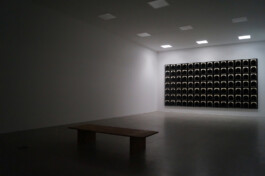
BLACK WALL _____ 30.08.2025 – 09.11.2025
UMBRELLA | West Coast Exhibitions, Nørre Nebel, DK
Icon means picture. Borrowed from Greek, the term generally refers to the pictorial representation, the material external image, traditionally known as a panel painting. As such, it differs fundamentally from our ideas of immaterial internal images, which derive from the Latin term imago. As a Christian cult picture that became established between the 4th and early 8th centuries, primarily in the Eastern Church, the icon, which follows in the tradition of ancient panel paintings, is revered as the true picture—the Vera Ikon. In sacred spaces, icons are regarded as “not painted pictures”, “pictures of heavenly origin, ” and “the seat of the divine being”. It is the ritual that prescribes clear rules, instructions and order for both the production and handling of the cult picture. The icon, the picture used in worship, appeals to the viewer. It makes a promise. It promises something. It promises nothing less than the appearance of a miracle through the picture. In the cult, at the centre of which the icons stand, the constant repetition of homage to the picture takes place, which presupposes the presence in the picture of what the picture shows us. In this respect, every cult picture fundamentally contradicts the essence of the picture, whose existence is always based on being something other than what it shows. The iconostasis, the “revered and much-kissed” wall of pictures that separates the altar area from the nave in Orthodox churches, signifies the drawing of a boundary line that establishes the sacred space, which is usually oriented towards the east.
This is where revelation is expected. It is an inaccessible space that differs from the profane space. A space that can only be approached in devotion or prayer. The arrangement of the icons on the wall follows strict rules. At the centre of the wall is the royal door, which potentially grants access and becomes the place of the expected revelation.
In the exhibition Black Wall, exhibition space becomes a kind of oratory. A place of contemplation, where we display 98 panels by Ukrainian artist Sofiia Yesakova from the series Blind Spot 2.1. – 2.100., which enter into dialogue with a sound piece created especially for the exhibition by German sound artist Sascha Kregel. An artistic dialogue that raises questions about contemporary art in the face of the ongoing terror of war and the darkness that it brings into our present, presented for the first time at umbrella.
For months, Sofiia Yesakova produced 100 almost identical picture panels in repetitive, monotonous work processes. In this contemplative work, the artist finds a way to intensively engage with the war, its horrors and its dynamics. A wall of pictures is formed on the north side of the exhibition space from 98 picture panels created using icon painting techniques and reminiscent of icons, i.e. Christian cult pictures, in their composition. Where the sun never shines, where no revelation is to be expected, the Black Wall emerges and denies the viewer access to another world. It promises him nothing. This wall is opaque. Our gaze bounces off this wall of pictures. It reaches a dead end. Here, we are not looked at by the true face. Instead of the Vera Icon, which traditionally shines out at us from icons, the empty black picture panels multiple-fold hold up a mirror to us. What we see is our own face. It is reflected in nothingness, in the emptiness of the black, faceless icon, and reveals the horror. The picture wall becomes a picture front, a tableau of horror, of which we become a part at the moment when our reflection looks back at us from there. The sacred format is ”desecrated” as the artist says, and transferred into a secular narrative in which both the individual panels and the entire wall of pictures are to be understood as a “visualised report of loss” and a “silent scream”. What the Black Wall shows is that representation can only fail, or perhaps must fail, in the face of the horrors of war.
From across the room, from the gallery on the south side of the exhibition space, the sound enters the room and fills it. The tonal systems created in Sascha Kregel's sound are not based on harmonic relationships between tones. Instead, he uses the surfaces and lines of drawings as a basis for creating his tonal ambiences, which are more random than planned and consist of arrhythmic minimal patterns, resonance fields and recurring noise. The resulting sound fields are mostly resonant. They are resonance fields formed by a collection of tonest hat are constantly moving themselves. Another essential aspect of Sascha Kregel’s sound is noise, which constantly present in every type of electronically generated sound—audible or inaudible—and, from technical perspective, becomes an indispensable part of the sound as a background. Contrary to the usual effort to minimize noise in favor of audibility, it is repeatedly brought to the forefront here, lending the sound depth and texture. In a constant alternation in which dark sound fields and latent noise sometimes come to the fore and sometimes recede into the background, and in the difference to the recurring interferer noise, the sound emerges and forms a dark, threatening wall of sound in the room, a sound space from which the exhibition visitor cannot escape. The listener is confronted with mostly monotonous soundscapes in which conciliatory harmonies only briefly emerge. Harmonies that, before they can calm the listener, are either cancelled out by interference noises or by the apparent nothingness of the permanent and audible noise, thus enabling a sound experience that is an audible response to Sofiia Yesakova's wall of pictures.
A large oak bench is placed in front of the picture wall and becomes an indispensable part of the exhibition. It invites visitors to stay, to see and to listen. Silently it urges them: Sit down, rest your tired legs until you don’t know what hit you.
Curated by Jan Wawrzyniak and Ulrike Kregel
Text by Ulrike Kregel on the exhibition Black Wall
Duo exhibition with artist Sascha Kregel
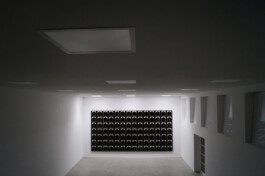
Blind Spot 2.1.-2.100., each 40 × 40 × 5, total 280 × 560 × 5 cm, Acrylic, gesso, gelatine, varnish on wooden board, 2025
Series of works Blind Spot evokes a psychological state of tension experienced by the viewer who sees only their own blurred reflection, an atmosphere of expectation, uncertainty, and emptiness. A mirrored yet murky surface. The reflection is present, but it does not yield a clear image. It evokes thesame cognitive discomfort we experience in the chaos of information. The “numerical screen” of the media, infographics and death counters turns grief into abstraction. The glossy surface acts as a “screen” onto which the imagination projects its own information. There is no concrete body. A number doesn’t smell like blood, doesn’t cry, doesn’t decay. The “iconnpanel” is stripped of the image of suffering. Instead of a wound, there is emptiness. This uncertainty creates internal stress, a psychological equivalent of anxiety, when danger is present, but the threat never materializes.
The series Blind Spot 2.1.–2.100. consists of 100 panels. This repetition and desacralization are an important part of the statement. Like news bulletins about new fronts and crises: the sheer number overwhelms, turning tragedy into background noise. The sacred format is transferred into a secular narrative. We expect consolation but receive only the horizontal plane of statistics and emptiness, hence the sensation of a “world abandoned by God.” Identical panels act as a visualized “casualty report”: anonymous, almost statistical. Their quantity and monotony transform silent horror into a mass, endless repetition of violence. The “mute scream” of the works emphasizes horror without an object. An iconostasis without icons visualizes the very structure of modern tension: the endless replication of traumatic events, the loss of the image of truth. Faced with condensed emptiness, the viewer is simultaneously under pressure, each sees only their own reflection, but collectively we share the same dark side of our world. The rhythm of repetition resembles liturgy, but the prayer is addressed not to God, but to the void, dramatizing the sense of abandonment. As a result, repetition exposes the method of statistics while simultaneously breaking through its numbing effect. Numbers don’t allow us to feel tragedy. Psychic numbing: the more victims there are, the weaker the emotional response, the brain shields itself fromoverload. The panels multiply, but the feeling remains at zero: the viewer realizes that a hundred feels the same as one.
All panels seem the same, individuality is erased, leaving an impersonal “single case.” This is how statistics work: methodologically, it “levels” the difference between lives for the sake of strict accounting. In this work, I chose rhythm over narrative. In an icon, there is a central event. Here, instead of an event—there is rhythm. Instead of a single sacred narrative, I propose a layered system. A reference to the icon-painting tradition, a sacred context. A clean, reflective surface gathers reflections of people, benches, the hall—reality is assembled from multiple fragments. An icon usually contains a revelation, but here there is only reflection, in which each person sees themselves.
The space is cathedral-like and oppressive: long “church” benches dictate the posture of the body (sitting, waiting, silence), while the number of identical panels exerts pressure. The benches create a ritual of waiting and co-presence. In a church, their function is to unite the congregation in prayer; here, to gather viewers in shared silence, the horror of war as a collective but unspoken experience. The mirrored emptiness emphasizes that behind every number is a face, yet we see only our own reflection—a sign of personal responsibility for someone else's “invisibility.” This work is not about numbers, but about how numbers kill feeling. Through repetition, you intensify the numbness to the point of loud, almost physical pressure, forcing the viewer to perceive the scale of the tragedy precisely through its apparent imperceptibility.
Text by Sofiia Yesakova on the series of works Blind Spot
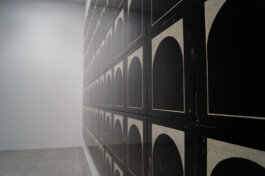
Blind Spot 2.1.-2.100., each 40 × 40 × 5, total 280 × 560 × 5 cm, Acrylic, gesso, gelatine, varnish on wooden board, 2025. Close-up
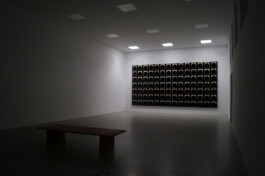
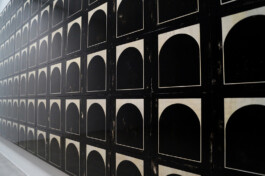
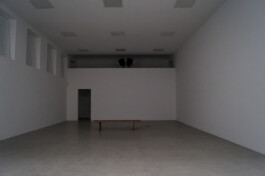
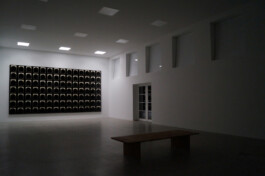
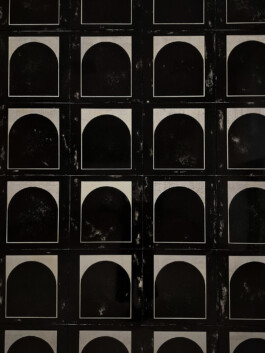

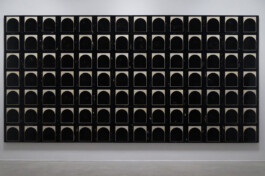
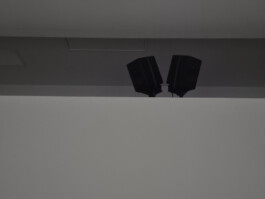
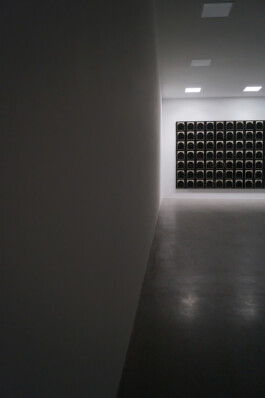
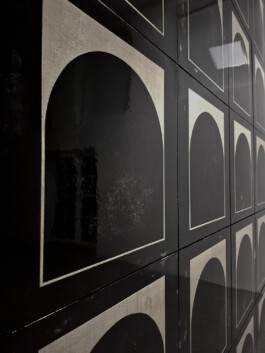
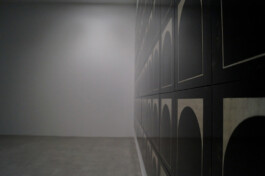
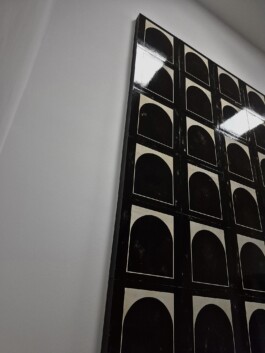
Blind Spot 2.1.-2.100., each 40 × 40 × 5, total 280 × 560 × 5 cm, Acrylic, gesso, gelatine, varnish on wooden board, 2025. Close-up